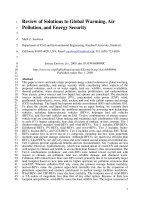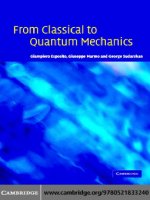- Trang chủ >>
- Khoa Học Tự Nhiên >>
- Vật lý
solutions to problems quantum mechanics
Bạn đang xem bản rút gọn của tài liệu. Xem và tải ngay bản đầy đủ của tài liệu tại đây (607.15 KB, 122 trang )
Solutions to Problems
in
Quantum Mechanics
P. Saltsidis, additions by B. Brinne
1995,1999
0
Most of the problems presented here are taken from the book
Sakurai, J. J., Modern Quantum Mechanics, Reading, MA: Addison-Wesley,
1985.
Contents
I Problems
1
2
3
4
5
Fundamental Concepts . . . . . . .
Quantum Dynamics . . . . . . . . .
Theory of Angular Momentum . . .
Symmetry in Quantum Mechanics .
Approximation Methods . . . . . .
II Solutions
1
2
3
4
5
Fundamental Concepts . . . . . . .
Quantum Dynamics . . . . . . . . .
Theory of Angular Momentum . . .
Symmetry in Quantum Mechanics .
Approximation Methods . . . . . .
1
3
.
.
.
.
.
.
.
.
.
.
.
.
.
.
.
.
.
.
.
.
.
.
.
.
.
.
.
.
.
.
.
.
.
.
.
.
.
.
.
.
.
.
.
.
.
.
.
.
.
.
.
.
.
.
.
.
.
.
.
.
.
.
.
.
.
.
.
.
.
.
.
.
.
.
.
5
7
14
17
19
.
.
.
.
.
.
.
.
.
.
.
.
.
.
.
.
.
.
.
.
.
.
.
.
.
.
.
.
.
.
.
.
.
.
.
.
.
.
.
.
.
.
.
.
.
.
.
.
.
.
.
.
.
.
.
.
.
.
.
.
.
.
.
.
.
.
.
.
.
.
. 25
. 36
. 75
. 94
. 103
23
2
CONTENTS
Part I
Problems
3
1. FUNDAMENTAL CONCEPTS
5
1 Fundamental Concepts
1.1 Consider a ket space spanned by the eigenkets fja0ig of a Hermitian operator A. There is no degeneracy.
(a) Prove that
Y
(A ; a0)
a0
is a null operator.
(b) What is the signi cance of
Y (A ; a00)
0
00 ?
a00 6=a0 a ; a
(c) Illustrate (a) and (b) using A set equal to Sz of a spin 21 system.
1.2 A spin 12 system is known to be in an eigenstate of S~ n^ with
eigenvalue h=2, where n^ is a unit vector lying in the xz-plane that
makes an angle with the positive z-axis.
(a) Suppose Sx is measured. What is the probability of getting
+h=2?
(b) Evaluate the dispersion in Sx, that is,
h(Sx ; hSx i)2i:
(For your own peace of mind check your answers for the special
cases = 0, =2, and .)
1.3 (a) The simplest way to derive the Schwarz inequality goes as
follows. First observe
(h j + h j) (j i + j i) 0
for any complex number then choose in such a way that the
preceding inequality reduces to the Schwarz inequility.
6
(b) Show that the equility sign in the generalized uncertainty relation holds if the state in question satis es
Aj i = B j i
with purely imaginary.
(c) Explicit calculations using the usual rules of wave mechanics
show that the wave function for a Gaussian wave packet given by
"
0 (x0 ; hxi)2 #
i
h
p
i
x
0
2
;
1
=
4
;
hx j i = (2 d ) exp
h
4d2
satis es the uncertainty relation
q
q
h( x)2i h( p)2i = h2 :
Prove that the requirement
hx0j xj i = (imaginary number)hx0j pj i
is indeed satis ed for such a Gaussian wave packet, in agreement
with (b).
1.4 (a) Let x and px be the coordinate and linear momentum in
one dimension. Evaluate the classical Poisson bracket
x F (px)]classical :
(b) Let x and px be the corresponding quantum-mechanical operators this time. Evaluate the commutator
x exp iphxa :
(c) Using the result obtained in (b), prove that
exp iphxa jx0i
(xjx0i = x0jx0i)
2. QUANTUM DYNAMICS
7
is an eigenstate of the coordinate operator x. What is the corresponding eigenvalue?
1.5 (a) Prove the following:
(i) hp0jxj i = ih @p@ 0 hp0j i
Z
@ (p0)
(ii) h jxj i = dp0 (p0)ih @p
0
where (p0) = hp0 j i and (p0) = hp0j i are momentum-space wave
functions.
(b) What is the physical signi cance of
exp ixh
where x is the position operator and is some number with the
dimension of momentum? Justify your answer.
2 Quantum Dynamics
2.1 Consider the spin-procession problem discussed in section 2.1
in Jackson. It can also be solved in the Heisenberg picture. Using
the Hamiltonian
eB S = !S
H = ; mc
z
z
write the Heisenberg equations of motion for the time-dependent
operators Sx(t), Sy (t), and Sz (t). Solve them to obtain Sx y z as functions of time.
2.2 Let x(t) be the coordinate operator for a free particle in one
dimension in the Heisenberg picture. Evaluate
x(t) x(0)] :
8
2.3 Consider a particle in three dimensions whose Hamiltonian is
given by
2
H = 2p~m + V (~x):
By calculating ~x p~ H ] obtain
* +
d h~x ~pi = p2 ; h~x r
~ V i:
dt
m
To identify the preceding relation with the quantum-mechanical
analogue of the virial theorem it is essential that the left-hand side
vanish. Under what condition would this happen?
2.4 (a) Write down the wave function (in coordinate space) for the
state
exp ;hipa j0i:
You may use
2
!23
0
x
hx0j0i = ;1=4x;0 1=2 exp 4; 21 x 5
0
0
@x0
h
m!
!1=21
A:
(b) Obtain a simple expression that the probability that the state
is found in the ground state at t = 0. Does this probability change
for t > 0?
2.5 Consider a function, known as the correlation function, de ned
by
C (t) = hx(t)x(0)i
where x(t) is the position operator in the Heisenberg picture. Evaluate the correlation function explicitly for the ground state of a
one-dimensional simple harmonic oscillator.
2. QUANTUM DYNAMICS
9
2.6 Consider again a one-dimensional simple harmonic oscillator.
Do the following algebraically, that is, without using wave functions.
(a) Construct a linear combination of j0i and j1i such that hxi is as
large as possible.
(b) Suppose the oscillator is in the state constructed in (a) at t = 0.
What is the state vector for t > 0 in the Schrodinger picture?
Evaluate the expectation value hxi as a function of time for t > 0
using (i) the Schrodinger picture and (ii) the Heisenberg picture.
(c) Evaluate h( x)2i as a function of time using either picture.
2.7 A coherent state of a one-dimensional simple harmonic oscillator is de ned to be an eigenstate of the (non-Hermitian) annihilation operator a:
aj i = j i
where is, in general, a complex number.
(a) Prove that
j i = e;j j =2e ay j0i
is a normalized coherent state.
(b) Prove the minimum uncertainty relation for such a state.
(c) Write j i as
1
X
j i = f (n)jni:
2
n=0
Show that the distribution of jf (n)j2 with respect to n is of the
Poisson form. Find the most probable value of n, hence of E .
(d) Show that a coherent state can also be obtained by applying
the translation ( nite-displacement) operator e;ipl=h (where p is the
momentum operator, and l is the displacement distance) to the
ground state.
10
(e) Show that the coherent state j i remains coherent under timeevolution and calculate the time-evolved state j (t)i. (Hint: directly apply the time-evolution operator.)
2.8 The quntum mechanical propagator, for a particle with mass
m, moving in a potential is given by:
K (x y E ) =
Z1
0
dteiEt=hK (x y t 0) = A
X sin(nrx) sin(nry)
E ; h22mr2 n2
n
where A is a constant.
(a) What is the potential?
(b) Determine the constant A in terms of the parameters describing
the system (such as m, r etc. ).
2.9 Prove the relation
d (x) = (x)
dx
where (x) is the (unit) step function, and (x) the Dirac delta
function. (Hint: study the e ect on testfunctions.)
2.10 Derive the following expression
m! h(x2 + 2x2 ) cos(!T ) ; x x i
Scl = 2 sin(
0 T
T
!T ) 0
for the classical action for a harmonic oscillator moving from the
point x0 at t = 0 to the point xT at t = T .
2.11 The Lagrangian of the single harmonic oscillator is
L = 21 mx_ 2 ; 12 m!2x2
2. QUANTUM DYNAMICS
11
(a) Show that
hxbtbjxatai = exp iShcl G(0 tb 0 ta)
where Scl is the action along the classical path xcl from (xa ta) to
(xb tb) and G is
G(0 tb 0 ta) =
Z
m
lim
dy
:
:
:
dy
1
N
N !1
2 ih"
(N +1)
2
8 N
9
=
1
2 ; "m! 2y 2
exp : h
(
y
;
y
)
j +1
j
j
2
j =0 2"
ta .
where " = (tNb;+1)
(Hint: Let y(t) = x(t) ; xcl(t) be the new integration variable,
xcl(t) being the solution of the Euler-Lagrange equation.)
(b) Show that G can be written as
(N +1) Z
2
m
G = Nlim
dy1 : : : dyN exp(;nT n)
!1 2 ih"
2 3
66 y..1 77
where n = 4 . 5 and nT is its transpose. Write the symmetric
yN
matrix .
(c) Show that
Z
dy1 : : : dyN
exp(;nT
n)
Z
dN ye;nT n
=p
N=2
det
Hint: Diagonalize by an orhogonal matrix.]
(d) Let 2mih" N det det N0 pN . De ne j j matrices j0 that consist of the rst j rows and j columns of N0 and whose determinants
are pj . By expanding j0 +1 in minors show the following recursion
formula for the pj :
pj+1 = (2 ; "2!2)pj ; pj;1
j = 1 ::: N
(2.1)
12
(e) Let (t) = "pj for t = ta + j" and show that (2.1) implies that in
the limit " ! 0 (t) satis es the equation
d2 = ;!2 (t)
dt2
with initial conditions (t = ta) = 0 d (tdt=ta) = 1.
(f) Show that
(
)
im!
m!
2
2
hxbtbjxatai = 2 ih sin(!T ) exp 2h sin(!T ) (xb + xa) cos(!T ) ; 2xaxb]
where T = tb ; ta.
s
2.12 Show the composition property
Z
dx1Kf (x2 t2 x1 t1)Kf (x1 t1 x0 t0) = Kf (x2 t2 x0 t0)
where Kf (x1 t1 x0 t0) is the free propagator (Sakurai 2.5.16), by
explicitly performing the integral (i.e. do not use completeness).
2.13 (a) Verify the relation
i
!
i
he
j] =
c "ijk Bk
where ~ m dt~x = ~p ; ecA~ and the relation
"
!#
2~x
~
d
1
d~
x
d~
x
d
~
~
~
m dt2 = dt = e E + 2c dt B ; B dt :
(b) Verify the continuity equation
@ +r
~ 0 ~j = 0
@t
2. QUANTUM DYNAMICS
with ~j given by
13
!
h
~ 0 ) ; e A~ j j2:
~j =
=
(
r
m
mc
2.14 An electron moves in the presence of a uniform magnetic eld
in the z-direction (B~ = B z^).
(a) Evaluate
x
where
y]
px ; eAc x
x
y
py ; eAc y :
(b) By comparing the Hamiltonian and the commutation relation
obtained in (a) with those of the one-dimensional oscillator problem
show how we can immediately write the energy eigenvalues as
!
2k 2
h
j
eB
j
h
E =
+
n+ 1
kn
2m
mc
2
where hk is the continuous eigenvalue of the pz operator and n is a
nonnegative integer including zero.
2.15 Consider a particle of mass m and charge q in an impenetrable
cylinder with radius R and height a. Along the axis of the cylinder runs a thin, impenetrable solenoid carrying a magnetic ux .
Calculate the ground state energy and wavefunction.
2.16 A particle in one dimension (;1 < x < 1) is subjected to a
constant force derivable from
V= x
( > 0):
14
(a) Is the energy spectrum continuous or discrete? Write down an
approximate expression for the energy eigenfunction speci ed by
E.
(b) Discuss brie y what changes are needed if V is replaced be
V = jxj:
3 Theory of Angular Momentum
3.1 Consider a sequence of Euler rotations represented by
!
;
i
;
i
2
3
(1
=
2)
exp
exp ;i 3
D (
) = exp
2
=
e;i( + )=2 cos 2
ei( ; )=2 sin
2
2
;e;i( ; )=2 sin 2
ei( + )=2 cos
2
2
!
:
Because of the group properties of rotations, we expect that this
sequence of operations is equivalent to a single rotation about some
axis by an angle . Find .
3.2 An angular-momentum eigenstate jj m = mmax = j i is rotated
by an in nitesimal angle
" about the y-axis. Without using the
(j )
explicit form of the dm0m function, obtain an expression for the
probability for the new rotated state to be found in the original
state up to terms of order "2.
3.3 The wave function of a patricle subjected to a spherically
symmetrical potential V (r) is given by
(~x) = (x + y + 3z)f (r):
3. THEORY OF ANGULAR MOMENTUM
15
(a) Is an eigenfunction of L~ ? If so, what is the l-value? If
not, what are the possible values of l we may obtain when L~ 2 is
measured?
(b) What are the probabilities for the particle to be found in various
ml states?
(c) Suppose it is known somehow that (~x) is an energy eigenfunction with eigenvalue E . Indicate how we may nd V (r).
3.4 Consider a particle with an intrinsic angular momentum (or
spin) of one unit of h. (One example of such a particle is the %meson). Quantum-mechanically, such a particle is described by a
ketvector j%i or in ~x representation a wave function
%i(~x) = h~x ij%i
where j~x ii correspond to a particle at ~x with spin in the i:th direction.
(a) Show explicitly that in nitesimal rotations of %i(~x) are obtained
by acting with the operator
u~" = 1 ; i h~" (L~ + S~)
(3.1)
where L~ = hi r^ r~ . Determine S~ !
(b) Show that L~ and S~ commute.
(c) Show that S~ is a vector operator.
(d) Show that r~ %~(~x) = h1 (S~ ~p)%~ where p~ is the momentum operator.
2
3.5 We are to add angular momenta j1 = 1 and j2 = 1 to form
j = 2 1 and 0 states. Using the ladder operator method express all
16
(nine) j m eigenkets in terms of jj1j2 m1m2i. Write your answer as
jj = 1 m = 1i = p1 j+ 0i ; p1 j0 +i : : :
2
2
where + and 0 stand for m1 2 = 1 0 respectively.
(3.2)
3.6 (a) Construct a spherical tensor of rank 1 out of two di erent
vectors U~ = (Ux Uy Uz ) and V~ = (Vx Vy Vz ). Explicitly write T (1)1 0 in
terms of Ux y z and Vx y z .
(b) Construct a spherical tensor of rank 2 out of two di erent
vectors U~ and V~ . Write down explicitly T (2)2 1 0 in terms of Ux y z
and Vx y z .
3.7 (a) Evaluate
j
X
m=;j
j)
jd(mm
0 ( )j2m
for any j (integer or half-integer) then check your answer for j = 21 .
(b) Prove, for any j ,
j
X
m=;j
m2jdm(j)0 m( )j2 = 12 j (j + 1) sin + m02 + 12 (3 cos2 ; 1):
Hint: This can be proved in many ways. You may, for instance,
examine the rotational properties of Jz2 using the spherical (irreducible) tensor language.]
3.8 (a) Write xy, xz, and (x2 ; y2) as components of a spherical
(irreducible) tensor of rank 2.
4. SYMMETRY IN QUANTUM MECHANICS
17
(b) The expectation value
Q eh j m = j j(3z2 ; r2)j j m = j i
is known as the quadrupole moment. Evaluate
eh j m0j(x2 ; y2)j j m = j i
(where m0 = j j ; 1 j ; 2 : : : )in terms of Q and appropriate ClebschGordan coe cients.
4 Symmetry in Quantum Mechanics
4.1 (a) Assuming that the Hamiltonian is invariant under time
reversal, prove that the wave function for a spinless nondegenerate
system at any given instant of time can always be chosen to be
real.
(b) The wave function for a plane-wave state at t = 0 is given by
a complex function ei~p ~x=h. Why does this not violate time-reversal
invariance?
4.2 Let (~p0) be the momentum-space wave function for state j i,
that is, (~p0) = h~p0 j i.Is the momentum-space wave function for the
time-reversed state j i given by (~p0, (;~p0), (~p0), or (;~p0)?
Justify your answer.
4.3 Read section 4.3 in Sakurai to refresh your knowledge of the
quantum mechanics of periodic potentials. You know that the energybands in solids are described by the so called Bloch functions
n k full lling,
ika
n k (x + a) = e
n k (x)
18
where a is the lattice constant, n labels the band, and the lattice
momentum k is restricted to the Brillouin zone ; =a =a].
Prove that any Bloch function can be written as,
X
ikR
n k (x) =
n (x ; Ri )e i
Ri
where the sum is over all lattice vectors Ri. (In this simble one dimensional problem Ri = ia, but the construction generalizes easily
to three dimensions.).
The functions n are called Wannier functions, and are important in the tight-binding description of solids. Show that the Wannier functions are corresponding to di erent sites and/or di erent
bands are orthogonal, i:e: prove
Z
dx ?m(x ; Ri) n(x ; Rj ) ij mn
Hint: Expand the n s in Bloch functions and use their orthonormality properties.
4.4 Suppose a spinless particle is bound to a xed center by a
potential V (~x) so assymetrical that no energy level is degenerate.
Using the time-reversal invariance prove
hL~ i = 0
for any energy eigenstate. (This is known as quenching of orbital
angular momemtum.) If the wave function of such a nondegenerate
eigenstate is expanded as
XX
l m
Flm(r)Ylm (
)
what kind of phase restrictions do we obtain on Flm(r)?
4.5 The Hamiltonian for a spin 1 system is given by
H = ASz2 + B (Sx2 ; Sy2):
5. APPROXIMATION METHODS
19
Solve this problem exactly to nd the normalized energy eigenstates and eigenvalues. (A spin-dependent Hamiltonian of this kind
actually appears in crystal physics.) Is this Hamiltonian invariant
under time reversal? How do the normalized eigenstates you obtained transform under time reversal?
5 Approximation Methods
5.1 Consider an isotropic harmonic oscillator in two dimensions.
The Hamiltonian is given by
2
p2y m!2 2 2
p
x
H0 = 2m + 2m + 2 (x + y )
(a) What are the energies of the three lowest-lying states? Is there
any degeneracy?
(b) We now apply a perturbation
V = m!2xy
where is a dimensionless real number much smaller than unity.
Find the zeroth-order energy eigenket and the corresponding energy to rst order that is the unperturbed energy obtained in (a)
plus the rst-order energy shift] for each of the three lowest-lying
states.
(c) Solve the H0 + V problem exactly. Compare with the perturbation results obtained in q(b). p
You may use hn0jxjni = h=2m! ( n + 1 0 + pn 0 ):]
n n+1
n n;1
5.2 A system that has three unperturbed states can be represented
by the perturbed Hamiltonian matrix
0
1
E1 0 a
B@ 0 E1 b CA
a b E2
20
where E2 > E1. The quantities a and b are to be regarded as perturbations that are of the same order and are small compared with
E2 ; E1. Use the second-order nondegenerate perturbation theory
to calculate the perturbed eigenvalues. (Is this procedure correct?)
Then diagonalize the matrix to nd the exact eigenvalues. Finally,
use the second-order degenerate perturbation theory. Compare
the three results obtained.
5.3 A one-dimensional harmonic oscillator is in its ground state
for t < 0. For t 0 it is subjected to a time-dependent but spatially
uniform force (not potential!) in the x-direction,
F (t) = F0e;t=
(a) Using time-dependent perturbation theory to rst order, obtain
the probability of nding the oscillator in its rst excited state for
t > 0). Show that the t ! 1 ( nite) limit of your expression is
independent of time. Is this reasonable or surprising?
(b) Can we nd higher
states?
q excited
p
0
You may use hn jxjni = h=2m! ( n + 1 n0 n+1 + pn n0 n;1 ):]
5.4 Consider a composite system made up of two spin 21 objects.
for t < 0, the Hamiltonian does not depend on spin and can be
taken to be zero by suitably adjusting the energy scale. For t > 0,
the Hamiltonian is given by
H = 4 2 S~1 S~2:
h
Suppose the system is in j + ;i for t 0. Find, as a function of
time, the probability for being found in each of the following states
j + +i, j + ;i, j ; +i, j ; ;i:
(a) By solving the problem exactly.
5. APPROXIMATION METHODS
21
(b) By solving the problem assuming the validity of rst-order
time-dependent perturbation theory with H as a perturbation switched
on at t = 0. Under what condition does (b) give the correct results?
5.5 The ground state of a hydrogen atom (n = 1,l = 0) is subjected
to a time-dependent potential as follows:
V (~x t) = V0cos(kz ; !t):
Using time-dependent perturbation theory, obtain an expression
for the transition rate at which the electron is emitted with momentum p~. Show, in particular, how you may compute the angular
distribution of the ejected electron (in terms of and de ned
with respect to the z-axis). Discuss brie y the similarities and the
di erences between this problem and the (more realistic) photoelectric e ect. (note: For the initial wave function use
1 Z 2e;Zr=a0 :
n=1 l=0 (~x) = p
a0
3
If you have a normalization problem, the nal wave function may
be taken to be
1
f (~x) =
L
3
2
ei~p ~x=h
with L very large, but you should be able to show that the observable e ects are independent of L.)
22
Part II
Solutions
23









